Is the floor always cold and the radiators spoil the view? There is a solution - baseboard heating
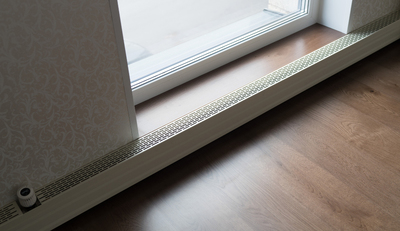
Skirting board heating is a common heating system today.
It allows to heat the air in the room evenly and quickly.
Skirting board heating appeared in our country relatively recently, but is already gaining popularity.
The essence of the skirting system: radiators, convectors, channels
Skirting board heating is a system of heat supply in which heating devices are placed along the walls, and the heat is distributed along the floor, thereby heating the baseboard and walls.
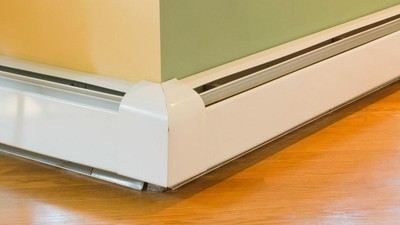
In other words, skirting board heating heats the floor, while the central heating system does not contribute to this - therefore the floor in apartments with such heating is always cold.
The structure includes the following elements:
- heating radiators;
- distribution manifold;
- convectors;
- plastic pipes.
Heating radiator consists of a heat exchanger, which is two copper pipes, and an aluminum box, which includes three strips with heating elements.
Distribution manifold — is a device made of two steel tubes with bends, outlets and thermal valves.
Plastic pipes - ordinary pipes that do not allow oxygen to pass through.
The principle of operation is based on the so-called Coanda effect: On any surface the air pressure is usually reduced, and on the surface of a large room there is always a flow of cold air.
Accordingly, the principle of operation of skirting board heating is designed in such a way that this cold air is heated. When the air enters the aluminum box, which is located near the floor and along the walls, it begins to heat up and rise to the walls. Thus, the heated air spreads along the walls, ensuring an optimal temperature throughout the entire room.
Skirting heating is different from a central heating system according to a number of indicators:

- no condensation, which usually settles on windows and walls;
- more uniform heat distribution;
- more quick heating of the room due to low thermal inertia;
- in a hydronic baseboard heating system less water required, to heat the room than in a traditional one;
- space along the walls remains free, whereas when using traditional heating, batteries take up a lot of space;
- design — baseboard heating acts as a decorative element: it can be mounted under any decorative panels;
- dust circulation comes to naught, as it reduces air turbulence.
The installation of such heating involves installation of heating radiators along the walls. First, a wall strip is fixed above the floor. Then, the convectors are connected into one system with fittings. Next, it is necessary to connect the distribution manifold to the heating main and check for leaks. Usually, such a system is fixed under the baseboard or any other panel, which is why it is actually called that.
As for technical characteristics, when purchasing a skirting board heating system, you should first of all pay attention to its heating element - the radiator. Volume, width, diameter — it is worth considering all these characteristics, as well as what power you need and how you will place all the elements of the system within the perimeter of the room.
Types of baseboard heating
There are two types:
- Water system
- Electric
Water. Difference from pipe layout
With the water type, the coolant (water) is supplied through a plastic tube to the radiators and then removed from them. The principle is almost the same as in a water central heating system - water circulation.
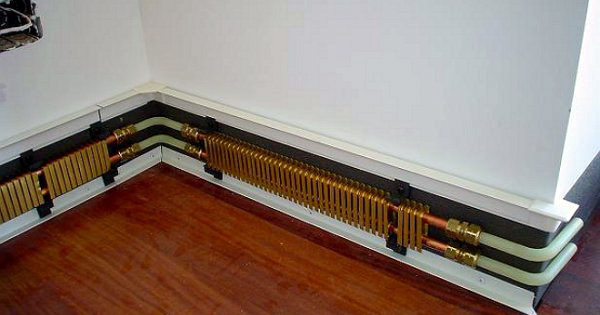
Photo 1. Baseboard heating of the water type. Pipes run along the baseboards, through which the heat carrier moves.
Only here there is no convection, that is, overheating of water, since the coolant is supplied through plastic pipes, and its maximum temperature should not exceed 85 degrees Celsius, and the pressure is three atmospheres.
Plastic the pipe through which water is supplied is mounted in the floor or in the wall. For safety reasons, it wrapped in corrugated material. This is no coincidence, since sooner or later the pipe will have to be replaced, and it will be quite easy to remove it from the corrugation. By the way, the plastic here was also chosen for a reason - it is resistant to the deposition of salts contained in water, and since the pipe does not allow oxygen to pass through, no oxides will form.
It is important to note here that water skirting heating is often confused with skirting heating pipe layout - method of supplying coolant to the radiatorOf course, these are different things.
Installation steps for water type:
- We measure the distance from the distribution manifold to the baseboard.
- Let's cut it off four tubes: two protective and two connecting. We insert the connecting pipe into the protective one and seal the ends with tape.
- We secure the plastic pipes with tape and bring them out onto the wall, 6 centimeters from the floor, We cover it with cement for reliable fixation. After that we can safely lay the floor.
- We stretch the aluminum edge along the entire length of the wall and secure it with tape.
- We place the profile and put special holders on it.
- We connect the heating pipes to the heating element using couplings and nuts.
- We connect the heating elements.
- We connect the heating system to the manifold, turn on the water and check the system operation. If a leak occurs during testing, you can secure the outlets with a wrench.
Electrical. Installation stages
Electric type built on an air electric heater, which is located inside the distribution radiators. It supplies heat from the heating element, which is distributed not through the outlet pipes, as in a water system, but through an electric cable. The cable's power is about 200 Watt.
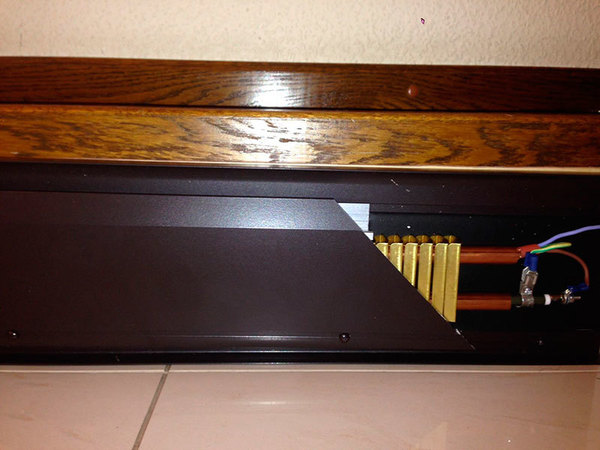
Photo 2. Electric baseboard heating system. Heating occurs due to an element that runs on electricity.
Electrical system is considered simpler and more convenient, than water, both in terms of installation and operation, because, in fact, all you need to do to make the system work is just plug the cable into the socket. However, installing an electric baseboard heating system is not so simple.
The thing is, the installation of the power cable involves 100% accuracy and absence of engineering errors. And since mistakes can be made, it is advisable to lay the power cable before pouring the floors in the house, plastering the walls and finishing the premises. Otherwise, if something happens, all this will have to be destroyed.
Stages of installation of an electric heating system:
- First you need to connect the power supply and stick the tape on the wall.
- We install the aluminum edge exactly as described above in the case of a traditional heating system.
- We install a thermostat.
- We insert the electric heating elements into the pipe and secure it with holders.
- We cover the heating system from the outside with a plastic box.
Advantages and disadvantages of the design
Among the obvious advantages of baseboard heating are:
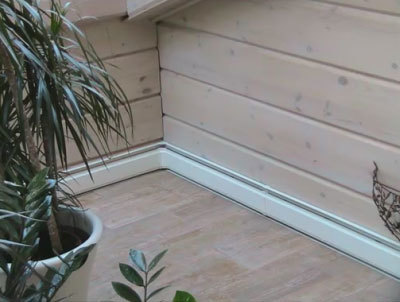
- rapid heating of the area;
- compact heating equipment;
- neat, aesthetic appearance;
- uniform heating of the entire room;
- minimal fuel consumption;
- temperature control, the ability to individually set the desired air temperature if special programs are available;
- simple and clear installation that consumers can do themselves.
However, there are also disadvantages. Here they are:
- high power of radiators, resulting in high electricity bills;
- high cost due to the use of expensive materials: copper, brass, aluminum; approximate price - three thousand rubles per square meter.
Useful video
Watch the video, which demonstrates the process of installing baseboard heating in an apartment.
Conclusion
In conclusion, we note that the installation of such a serious matter as heating, It is worth trusting competent and experienced specialists, and baseboard ones especially.
Attention! It needs to be laid at the stage of finishing the apartment, when the walls have not yet been plastered, so as not to destroy what has been done later in case of a miscalculation.
Skirting board heating differs from traditional heating in many ways, but perhaps the most important is that rapid heating of the room and its uniform distribution. And also its undoubted advantage is ease of use and compact placement. Skirting heating is usually found in private houses, garages, balconies and loggias.








Comments